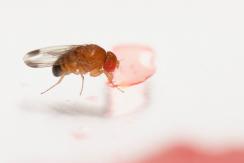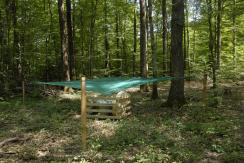Evolutionary Ecology
The department of Evolutionary Ecology gathers complementary skills in behavioural ecology, population dynamics, population biology, community ecology, and methodology (statistics and modelling). The research done in the department aims at studying how animal species evolve in a changing world by understanding the causes of the evolution of traits, adaptations and interactions. For that, we consider different levels of organization from individuals to populations and communities. Because organisms cannot be considered isolated from other biotic factors, we consider pathogens but also competing species within communities.
We study how individuals adapt to their environments that are largely impacted by anthropic pressures, and how life history traits and behaviour evolve in response to these pressures. Although we mainly focus on phenotype, we more and more consider the mechanistic link between the genotype and the phenotype. We develop the theoretical framework of our discipline through a conceptual and modeling approach. In parallel, we test hypotheses that arise from theoretical predictions through experimental, comparative and observational approaches on different biological models (insects, birds, mammals). Experimental approaches are developed in the laboratory (insect model) and in natura (bird, insect and mammal models). Observational and comparative research is mainly concerned with vertebrates. Our approaches are also, and increasingly, interested in the mechanisms of adaptive responses. In addition to the classical approaches of demographic analysis and trait change, methods of ecophysiology, chemical ecology and molecular biology are used.
Our department hosts several long-term studies of wild populations of different species. These long-term studies offer a valuable way to understand how biotic and abiotic factors affect individuals’ life history traits, and the functioning of populations in natura. Five populations of mammalian species are thus monitored for several years (more than 40 years on roe deer, 30 on Alpine marmots, 25 years on cats, 16 years on zebras, and 20 years on impala). Two of our study sites (La Sassière in Vanoise National Park (Alpine marmots) and Hwange National Park) have been certified as “Site d’Etude en Ecologie Globale” (SEEG), and two (ZA “Hwange” and ZA “Antarctic and sub-Antarctic”) were certified as “Zone Atelier” by the CNRS.
The department of Evolutionary ecology is also largely involved in training activities. Lastly, we also have strong socio-economic relationships. Indeed, because we address questions of major societal interest (global warming, public health) we tightly collaborate with socio-economic partners (Office Français de la Biodiversité, Vanoise National Park, Hwange National Park in Zimbabwe, Office National des Forêts, etc.) and participate to general public and media events.
Publications
Display of 901 to 930 publications on 2459 in total
Simple parametric tests for trait–environment association
Journal of Vegetation Science . 29 ( 5 ) : 801-811
DOI: 10.1111/jvs.12666
Journal article
see the publicationSupervised Multiblock Analysis in R with the ade4 Package
Journal of Statistical Software . 86 ( 1 )
Journal article
see the publicationBiased estimation of trends in cohort effects: the problems with age‐period‐cohort models in ecology
Ecology . 99 ( 12 ) : 2675-2680
DOI: 10.1002/ecy.2545
Journal article
see the publicationHigh Shedding Potential and Significant Individual Heterogeneity in Naturally-Infected Alpine ibex (Capra ibex) With Brucella melitensis
Frontiers in Microbiology . 9 : 1065
Journal article
see the publicationSelf-clearance of Pestivirus in a Pyrenean Chamois (Rupicapra pyrenaica) Population
Journal of wildlife diseases . 54 ( 2 ) : 335-341
DOI: 10.7589/2017-03-055
Journal article
see the publicationBack and forth Wolbachia transfers reveal efficient strains to control spotted wing drosophila populations
Journal of Applied Ecology . 55 ( 5 ) : 2408-2418
Journal article
see the publicationNo evidence for prezygotic postcopulatory avoidance of kin despite high inbreeding depression.
Molecular Ecology . 27 ( 24 ) : 5252-5262
DOI: 10.1111/mec.14951
Journal article
see the publicationReconciling the biogeography of an invader through recent and historic genetic patterns: the case of topmouth gudgeon Pseudorasbora parva
Biological Invasions . 20 ( 8 ) : 2157-2171
Journal article
see the publicationMOSAIC: a web-interface for statistical analyses in ecotoxicology
Environmental Science and Pollution Research . 25 ( 12 ) : 11295-11302
Journal article
see the publicationDoes multiple paternity explain phenotypic variation among offspring in wild boar?
Behavioral Ecology . 29 ( 4 ) : 904-909
Journal article
see the publicationCircadian periodicity in space use by ungulates of temperate regions: How much, when and why?
Journal of Animal Ecology . 87 ( 5 ) : 1299-1308
Journal article
see the publicationMOSAIC : une plate-forme web pour l’analyse statistique des données d’écotoxicologie. Fiche Thématique N°13
: 4 p.
DRomics: A Turnkey Tool to Support the Use of the Dose–Response Framework for Omics Data in Ecological Risk Assessment
Environmental Science and Technology . 52 ( 24 ) : 14461-14468
Journal article
see the publicationAssessment of Ozone or Not-Treated Wastewater Ecotoxicity Using Mechanism-Based and Zebrafish Embryo Bioassays
Journal of Environmental Protection . 09 ( 04 ) : 325 - 346
Journal article
see the publicationInsect personality: what can we learn from metamorphosis?
Current Opinion in Insect Science . 27 : 46-51
Journal article
see the publicationSex gap in aging and longevity: can sex chromosomes play a role?
Biology of Sex Differences . 9 ( 1 ) : 1-14
Journal article
see the publicationMaternal reproductive senescence shapes the fitness consequences of the parental age difference in ruffed lemurs
Proceedings of the Royal Society B: Biological Sciences . 285 ( 1886 ) : 20181479
Journal article
see the publicationModelling allometry: statistical and biological considerations – a reply to Packard
Biological Journal of the Linnean Society . 125 ( 3 ) : 664-671
Journal article
see the publicationSelective laser sintering of porcelain
Journal of the European Ceramic Society . 38 ( 2 ) : 769-775
Journal article
see the publicationRobust Frankia phylogeny, species delineation and intraspecies diversity based on Multi-Locus Sequence Analysis (MLSA) and Single-Locus Strain Typing (SLST) adapted to a large sample size
Systematic and Applied Microbiology . 41 ( 4 ) : 311-323
Journal article
see the publicationChauves-souris et services écosystémiques : que nous apprend l'ADN contenu dans le guano?
Congrès Ecolo’Tech .
Conference paper
see the publicationHistoire évolutive et taxonomie intégrative dans le genre Gerbillus (Rodentia: Muridae)
Bulletin de la société d'histoire naturelle de l'Afrique du Nord . 74 : 43-55
Journal article
see the publicationDivergent in shape and convergent in function: adaptive evolution of the mandible in Sub-Antarctic mice
Evolution - International Journal of Organic Evolution . 72 ( 4 ) : 878-892
DOI: 10.1111/evo.13467
Journal article
see the publicationAssessing the composition of fragmented agglutinated foraminiferal assemblages in ancient sediments: comparison of counting and area-based methods in Famennian samples (Late Devonian)
Journal of Micropalaeontology . 37 ( 1 ) : 87-95
Journal article
see the publicationThe repeatability of cognitive performance: a meta-analysis
Philosophical Transactions of the Royal Society B: Biological Sciences . 373 : 1756
Journal article
see the publicationIntegrating spatial and phylogenetic information in the fourth‐corner analysis to test trait–environment relationships
Ecology . 99 ( 12 ) : 2667-2674
DOI: 10.1002/ecy.2530
Journal article
see the publicationRegulated hunting re-shapes the life history of brown bears
Nature Ecology & Evolution . 2 ( 1 ) : 116 - 123
Journal article
see the publicationAvis de l’Anses relatif à une évaluation du risque lié au dépeuplement d’élevages porcins, opérations mises en œuvre en cas de foyers de PPA en élevage
: 21 p.
Report
see the publicationComparison of Three Methods to Assess the Potential for Bushpig-Domestic Pig Interactions at the Wildlife—Livestock Interface in Uganda
Frontiers in Veterinary Science . 5 ( 295 ) : 1-13
Journal article
see the publication





You also, comment on this article